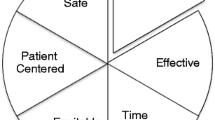Abstract
This study examines whether specific organizational characteristics, such as hospital size, geographic location (urban versus rural), system membership (stand-alone versus system-affiliated), and tax status (for-profit versus non-profit), influence adoption of healthcare information technologies (HIT) in hospitals. We hypothesize the above organizational characteristics to be related to hospitals’ adoption of clinical, administrative, and strategic HIT, as well as all HIT in general. Using survey data collected from 98 Florida hospitals, we demonstrate that hospital size, system membership, and tax status, but not geographic location, are systematically related to HIT adoption, and that such factors explain about 28–41% of the adoption variance. A mixed pattern of effects emerge for clinical, administrative, and strategic HIT. For instance, hospital size appears to be less relevant for administrative HIT, where its effect is compensated by those of system membership and tax status. Implications for future HIT research and practice are discussed.
Similar content being viewed by others
References
Medicare Payment Advisory Council (2006) Report to the Congress: Medicare payment policy. http://www.medpac.gov/publications/congressional_reports/Mar06_TitlepgInsidecovAcknow.pdf
The Lewin Group (2005) Health information technology: final report. http://www.hhs.gov/healthit/HITFinalReport.pdf
Freudenheim M (2004) Many hospitals resist computerized patient care. New York Times. http://www.nytimes.com/2004/04/06/technology/06errors.html
Agency for Health Care Policy and Research (1992) Effective dissemination of health and clinical information and research findings. U.S. Department of Health and Human Services, Washington, DC
HFMA (2006) Overcoming barriers to electronic health record adoption: results of survey and roundtable discussions conducted by the healthcare financial management association. http://www.hfma.org
Bower AG (2005) The diffusion and value of healthcare information technology. RAND, Santa Monica
Morrissey J (2003) An info-tech disconnect. Mod Healthc 33(6):6–14
Brailer D (2005) Economic perspectives on health information technology. Bus Econ 40(3):6–14
Burke DE, Wang BBL, Wan TTH, Diana ML (2002) Exploring hospitals’ adoption of information technology. J Med Syst 26(4):349–355
Kocakülâh MC, Upson J (2005) Cost analysis of computerized physician order entry using value stream analysis: a case study. Res Healthc Financ Manag 10(1):13–25
Ash J (1997) Organizational factors that influence information technology diffusion in academic health sciences centers. J Am Med Inform Assoc 4(2):102–111
Ash JS, Gorman PN, Seshadri V, Hersh WR (2004) Computerized physician order entry in U.S. hospitals: results of a 2002 survey. J Am Med Inform Assoc 11(2):95–99
Parente ST, Van Horn RL (2007) Valuing hospital investment in information technology: does governance make a difference? Health Care Financ Rev 28(2):31–43
Dorenfest IHDS + Database, HIMSS Analytics, Chicago, IL
Kimberly JK, Evanisko MJ (1981) Organizational innovation: the influence of individual, organizational, and contextual factors on hospital adoption of technological and administrative innovation. Acad Manage J 24(4):689–713
Damanpour F (1987) The adoption of technological, administrative, and ancillary innovations: impact of organizational factors. J Manage 13(4):675–688
Dewar RD, Dutton JE (1986) The adoption of radical and incremental innovations: an empirical analysis. Manage Sci 32(11):1422–1433
Menachemi N, Burkhardt J, Shewchuk R, Burke D, Brooks R (2006) Hospital information technology and positive financial performance: a different approach to ROI. J Healthc Manag 51(1):263–268
Meyer AD, Goes JB (1988) Organizational assimilation of innovations: a multilevel contextual analysis. Acad Manage J 31(4):897–923
Katz ML, Shapiro C (1986) Technology adoption in the presence of network externalities. J Polit Econ 94(4):822–841
Carey K (2003) Hospital cost efficiency and system membership. Inquiry 40(1):25–38
Robinson JC (2002) Bond-market skepticism and stock-market exuberance in the hospital industry. Health Aff 21(1):104–117
Corder K (2001) Acquiring new technology: comparing nonprofit and public sector agencies. Adm Soc 33(2):194–219
Menachemi N, Burke D, Brooks RG (2004) Adoption factors associated with patient safety-related information technology. J Healthc Qual 26(6):39–44
Brooks RN, Menachemi N, Burke D, Clawson A (2005) Patient safety-related information technology utilization in urban and rural hospitals. J Med Syst 29(2):103–109
Calico FW, Dillard CD, Moscovice I, Wakefield MK (2003) A framework and action agenda for quality improvement in rural health care. J Rural Health 19(3):226–232
Dorenfest S (2000) The decade of the ‘90s. Poor use of IT investments contributes to growing healthcare crisis. Healthc Inform 17(8):64–67
Pare G, Sicotte C (2001) Information technology sophistication in health care: an instrument validation study among Canadian hospitals. Int J Med Inform 63(3):205–223
iHealthBeat (2002) AHRQ chief calls for ROI evidence in health IT. http://www.ihealthbeat.org/articles/2004/2/25/AHRQ-Chief-Calls-for-ROI-Evidence-in-Health-IT.aspx
iHealthBeat (2004) Large health systems committed to IT, but measurable ROI remains elusive. http://www.ihealthbeat.org/articles/2002/2/7/Large-health-systems-committed-to-IT-but-measurable-ROI-remains-elusive.aspx
Author information
Authors and Affiliations
Corresponding author
Rights and permissions
About this article
Cite this article
Hikmet, N., Bhattacherjee, A., Menachemi, N. et al. The role of organizational factors in the adoption of healthcare information technology in Florida hospitals. Health Care Manage Sci 11, 1–9 (2008). https://doi.org/10.1007/s10729-007-9036-5
Received:
Accepted:
Published:
Issue Date:
DOI: https://doi.org/10.1007/s10729-007-9036-5




